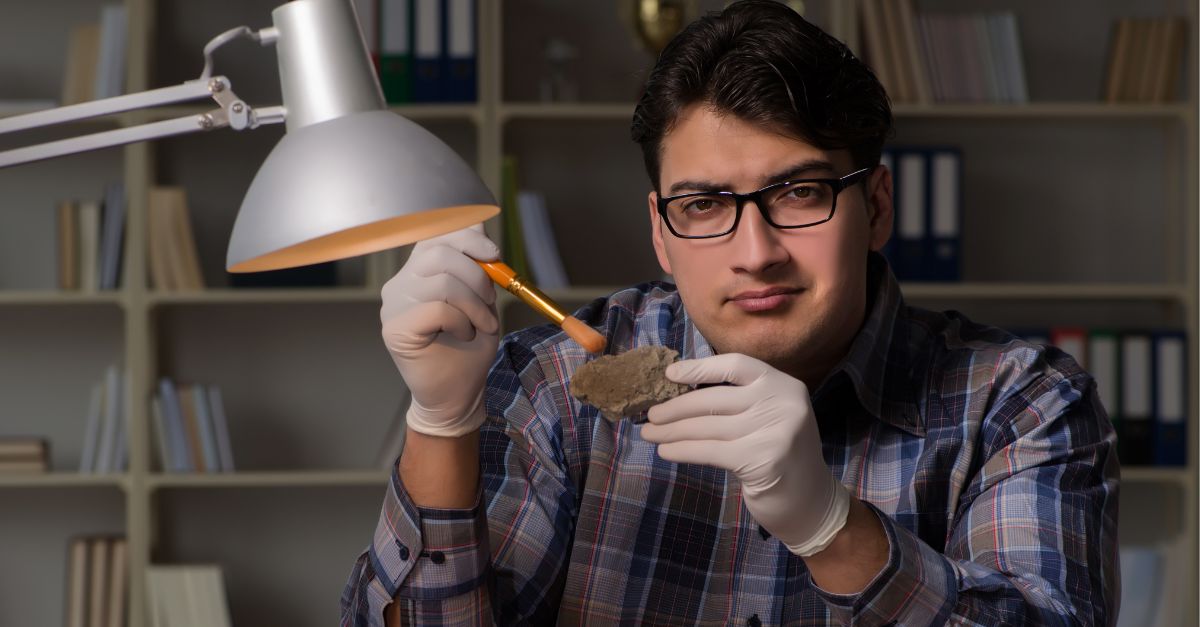Buried Evidence Resurfaces
Archaeologists weren’t looking for a forgotten language when they pulled a carved stone from a riverbed in Georgia. Nor did anyone expect ice cores to link industrial pollution to Roman intelligence. Yet each revelation has opened doors where none were seen.

A Never-Seen-Before Inscription In Georgia
Fishermen discovered a basalt tablet bearing 60 symbols—39 of them unique—arranged into seven columns in Georgia’s Dmanisi region. Dated to the Late Bronze or Early Iron Age (first millennium BCE), the inscription appears in a previously unknown script. Its purpose—whether ritual or record—is still undeciphered.
 Georgian National Museum, Wikimedia Commons
Georgian National Museum, Wikimedia Commons
Lead Pollution Led To A Drop In Roman IQ
Recent ice-core analysis shows that atmospheric lead pollution from Roman-era mining peaked during the Pax Romana, reducing average IQ by approximately 2 to 3 points across Europe. Children suffered from high blood lead levels, which impaired cognition across the empire. This environmental legacy explains how industrial activity subtly shaped ancient human capacity.
 Junta Informa, Wikimedia Commons
Junta Informa, Wikimedia Commons
Aboriginal Ice Age Ritual Site, Victoria, Australia
Aboriginal remains and Ice Age artifacts found in 2024 near Victoria’s Cloggs Cave mark one of the oldest known ritual sites in Australia. With hearths and ceremonial placement, the site adds rich detail to Indigenous lifeways. It supports oral traditions, suggesting deep spiritual and environmental stewardship over millennia.
 KTWPhotography, Wikimedia Commons
KTWPhotography, Wikimedia Commons
Tomb Of Roman Soldier “Flaccus,” Heerlen, Netherlands
Beneath a quiet residential street in Heerlen, the grave of a Roman soldier named Flaccus came to light. Carved inscriptions and well-preserved belongings revealed not just his identity, but a life shaped by service on the empire’s northern edge. The burial offers a rare glimpse into Rome’s reach—and its human cost.
 Thermen museum heerlen by Parkstad In the picture
Thermen museum heerlen by Parkstad In the picture
HMS Hind Shipwreck, Sanday, Scotland
After a winter storm stripped away centuries of sand, the HMS Hind—a long-lost 18th-century Royal Navy warship—surfaced along Orkney’s rugged coast. Confirmed through archival plans and local surveys, the wreck connects Scotland to Revolutionary War maritime history and highlights how environmental shifts can expose priceless historical treasures.
 British warship with Canadian ties identified from shipwreck on Orkney by Global News
British warship with Canadian ties identified from shipwreck on Orkney by Global News
Pompeii Blue Sacrarium, Regio IX, Italy
A 2024 excavation in Regio IX, Pompeii, uncovered a rare blue-painted sacrarium—an intimate shrine room likely used for household worship. The intense blue pigment, symbolically potent and economically costly, hints at the spiritual priorities and affluence of its owners. This site deepens the understanding of domestic ritual space in Roman homes.
 Pompei, scavi nella Regio IX rivelano un sacrario con pareti blu by Pompeii
Pompei, scavi nella Regio IX rivelano un sacrario con pareti blu by Pompeii
Early Human Cave Art, Indonesia
Depicting hunters and wild pigs in motion, a striking cave painting found in Sulawesi has been dated to 51,200 years ago, making it the oldest known example of narrative art. Announced in 2024, this discovery challenges long-held assumptions about the origins of storytelling and symbolic thought in early human societies.
 World's oldest animal cave painting in Indonesia - BBC News by BBC News
World's oldest animal cave painting in Indonesia - BBC News by BBC News
El Cano Lord’s Tomb, Panama
In 2024, archaeologists excavated a richly adorned tomb in El Cano, Panama, which dates to around 750 CE. Containing gold breastplates and sacrificial victims, the burial reveals elite power rituals within the Gran Cocle culture. This high-status interment reframes Central American archaeology and highlights advanced social hierarchies before European contact.
 Melissa Wong Zhang, Wikimedia Commons
Melissa Wong Zhang, Wikimedia Commons
Aswan’s Great Necropolis, Egypt
Egypt’s Ministry of Antiquities revealed a new sector of Aswan’s Great Necropolis in 2024, uncovering high-status burials with gilded masks and ceremonial tools. These tombs, dated to the Late Period, provide direct evidence of localized administrative elites and artistic refinement. They enrich interpretations of Nubian-Egyptian cultural intersections along the Nile corridor.
 Egypt: Aswan and the Temple of Philae by Best Documentary
Egypt: Aswan and the Temple of Philae by Best Documentary
Etruscan Tomb Near San Giuliano, Italy
Archaeologists revealed an untouched Etruscan tomb near San Giuliano, complete with over 100 grave goods, such as bowls and weapons. Its extraordinary preservation provides a direct window into elite life and funerary rites from Italy’s pre-Roman civilization, and broadens our understanding of early Italic power and ritual aesthetics.
 Archaeologists Open Untouched Etruscan Tomb in Italy by LendianTV
Archaeologists Open Untouched Etruscan Tomb in Italy by LendianTV
Roman Basilica In London
Beneath the heart of modern London, workers exposed a monumental Roman basilica from the 1st century CE. This early civic complex was likely used for administrative and religious affairs. The find reconfigures historical timelines and suggests urban sophistication previously unconfirmed in early Roman Britain.
 London's first Roman basilica found under office basement | BBC News by BBC News
London's first Roman basilica found under office basement | BBC News by BBC News
Roman Settlement Near Willersey, England
A chance signal from a hobbyist's metal detector in Gloucestershire led to the discovery of a sprawling Roman site in 2025. Coins and foundations of a villa emerged from the soil. This surprise shows how ordinary environments still hide chapters of ancient empires and cross-cultural exchange.
Ancient City Discovered In Tonga
Advanced aerial scanning in 2024 mapped nearly 10,000 mounds on Tonga’s Tongatapu island, identifying an extended urban settlement dating back to around 300 CE. Once invisible beneath the forest canopy, this city rewrites Pacific history by confirming that organized urban life emerged centuries earlier than previously believed.
 European Space Agency, Wikimedia Commons
European Space Agency, Wikimedia Commons
Valeriana, Lost Maya City, Campeche, Mexico
Announced in late 2024, the Maya city of Valeriana appeared through scans in Campeche’s dense forests. Hidden for centuries, the site showed pyramids and reservoirs. Valeriana’s complexity suggests centralized governance and regional influence, and offers critical insight into Maya urbanism during periods of transition and ecological adaptation.
 Ancient Mayan city discovered in Mexico jungle by accident | BBC News by BBC News
Ancient Mayan city discovered in Mexico jungle by accident | BBC News by BBC News
Tava Tepe Ritual Feasting Structure, Azerbaijan
Tava Tepe revealed a circular Bronze Age structure built for communal feasting in 2024. Clay vessels were found precisely placed in concentric arrangement, which suggests ritualized dining practices. This site deepens understanding of early Caucasus societies, indicating that social cohesion and ceremony were central even in prehistoric upland communities.
 Tava Tepe: Arriving at the archaeological site by CAMNES Studio
Tava Tepe: Arriving at the archaeological site by CAMNES Studio
The Ancestors Of Hittites
Recent genetic research traces Hittite ancestry to populations mixing Anatolian farmers (80‑90 %) with steppe migrants (10‑20 %) between 5000 and 3000 BCE. These Proto-Anatolian speakers entered central Anatolia and forged the foundation of the Hittite civilization. Such a blend underpins the emergence of the earliest known Indo‑European language.
 Klaus-Peter Simon, Wikimedia Commons
Klaus-Peter Simon, Wikimedia Commons
Celtic Settlement Near Hradec Kralove, Czech Republic
A 2,200-year-old Celtic site was excavated in 2025 and showed gold, silver coins, and ritual enclosures. Its rich material culture points to an economically vibrant settlement connected to trans-European trade. The discovery significantly sheds light on Bohemia's profile within Iron Age Europe and suggests complex sociopolitical structures previously unrecognized in the region.
 HOWI - Horsch, Willy, CC BY-SA 4.0, Wikimedia Commons
HOWI - Horsch, Willy, CC BY-SA 4.0, Wikimedia Commons
Bronze-Age Settlement In Wolmirstedt, Germany
In July 2025, archaeologists uncovered a vast Bronze Age community in Saxony-Anhalt, complete with houses and tools. Covering over 21,000 square meters, the site reflects early urban planning and artisan production. It offers rare insight into settlement continuity and everyday life in Central Europe nearly 3,000 years ago.
 Bronze Age Village by Professor Rob's Channel
Bronze Age Village by Professor Rob's Channel
Cova De Les Dones, Spain
Ongoing excavations at this Catalonian cave in 2024–2025 exposed over 100 Paleolithic engravings alongside Roman coins and inscriptions. Used across millennia for ritual, the site exposes an extraordinary timeline of spiritual continuity. Its multi-era stratigraphy highlights the sacred geography of Iberian lands from the Ice Age to imperial antiquity.
Avalanche Of Discoveries In Sijilmassa, Morocco
Sijilmassa, once a trans-Saharan trade hub, showed unprecedented finds in 2024–2025. Among them: North Africa’s oldest mosque, a minting workshop, and gilded architectural fragments. These layers of commercial and residential life reconstruct a vibrant medieval city whose influence stretched from Andalusia to West Africa through gold and scholarship.
Southwark Roman Villa Frescoes, London
London’s Southwark district revealed Britain’s largest collection of Roman frescoes in 2025. Buried beneath modern construction, the vividly painted walls suggest that an elite villa once stood here. These artworks redefine perceptions of Roman life in Britain, indicating luxury and Mediterranean aesthetics thriving far beyond Rome.
 Huge Roman 'jigsaw' reveals 2,000-year-old wall paintings (UK) 19/June/2025 by Mark 1333
Huge Roman 'jigsaw' reveals 2,000-year-old wall paintings (UK) 19/June/2025 by Mark 1333
Moche Queen Burial, Panamarca, Peru
Designated as one of 2024’s top finds, the tomb of a Moche queen emerged from Peru’s Panamarca site. Decorated with gold and iconographic textiles, the burial highlights the status and influence of elite women in Andean cultures. It challenges assumptions about gender roles and leadership in pre-Columbian South America.
How Ancient Breeding Transformed Horses Forever
Around 3500 BCE, selective horse breeding practices emerged on the steppes of Eurasia, marking a turning point in equine history. Recent genetic studies show that modern domestic horses trace largely to a single lineage favored for endurance and temperament. This moment shaped warfare, trade, and mobility across entire civilizations.
 Peretz Partensky, CC BY-SA 2.0, Wikimedia Commons
Peretz Partensky, CC BY-SA 2.0, Wikimedia Commons
Reindeer Hunters’ Wall, Baltic Sea
Marine archaeologists in 2024 discovered a submerged Mesolithic hunting structure beneath the Baltic Sea. Over half a mile long and made of stones, the wall likely funneled reindeer during seasonal migrations. This underwater find provides a rare insight into Ice Age ingenuity and shows early humans’ mastery of coordination and survival.
 11,000-year-old “Stone Age wall” discovered in Baltic Sea by Global News
11,000-year-old “Stone Age wall” discovered in Baltic Sea by Global News
Mongolian Mass Grave Reveals Lives Lost In Battle
Seventeen skeletons uncovered in a single grave at the Urd Ulaan Uneet site in Mongolia were recently identified as male warriors, likely victims of Iron Age conflict. Forensic analysis showed trauma consistent with combat, which sheds light on ancient warfare and the violent realities of nomadic steppe societies.
 Ulaanbaatar - Shockingly Different Side of Mongolia 🇲🇳 | Ep#08 by The Roaming Jhola
Ulaanbaatar - Shockingly Different Side of Mongolia 🇲🇳 | Ep#08 by The Roaming Jhola











